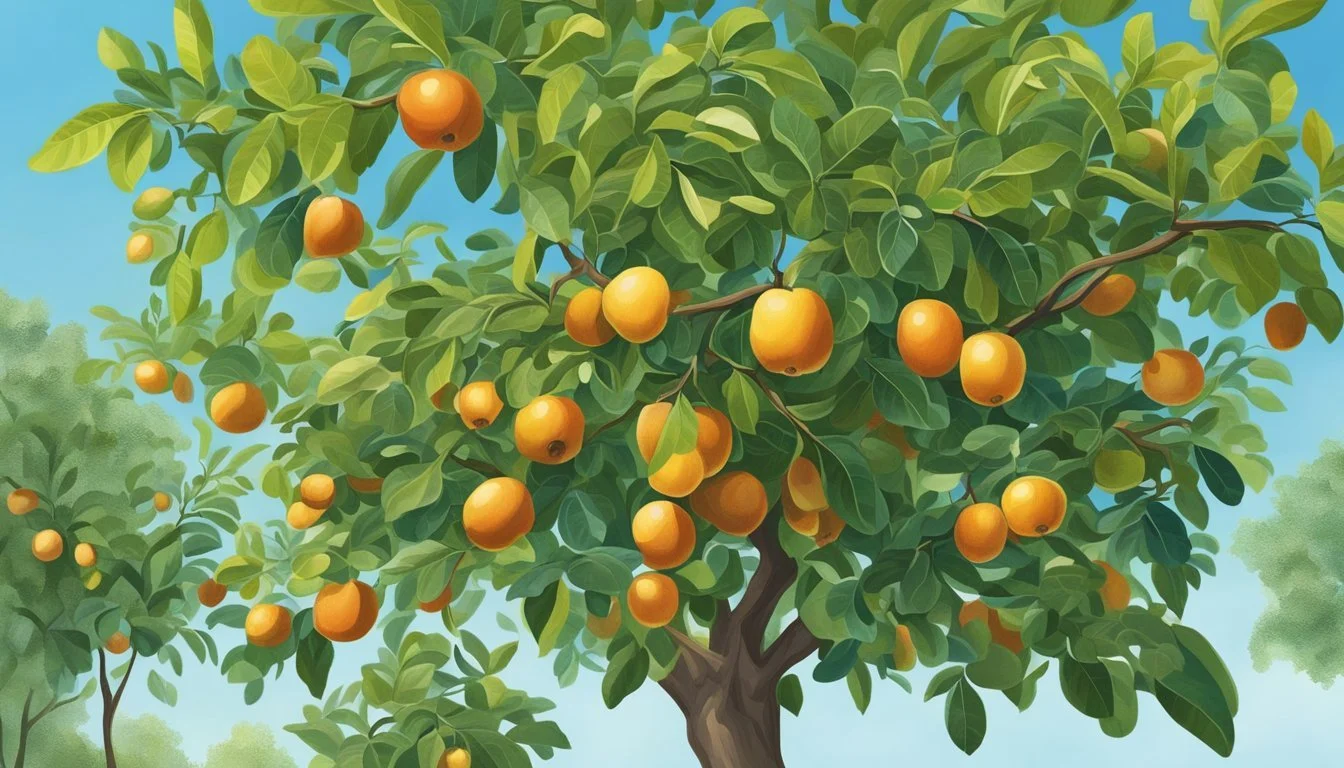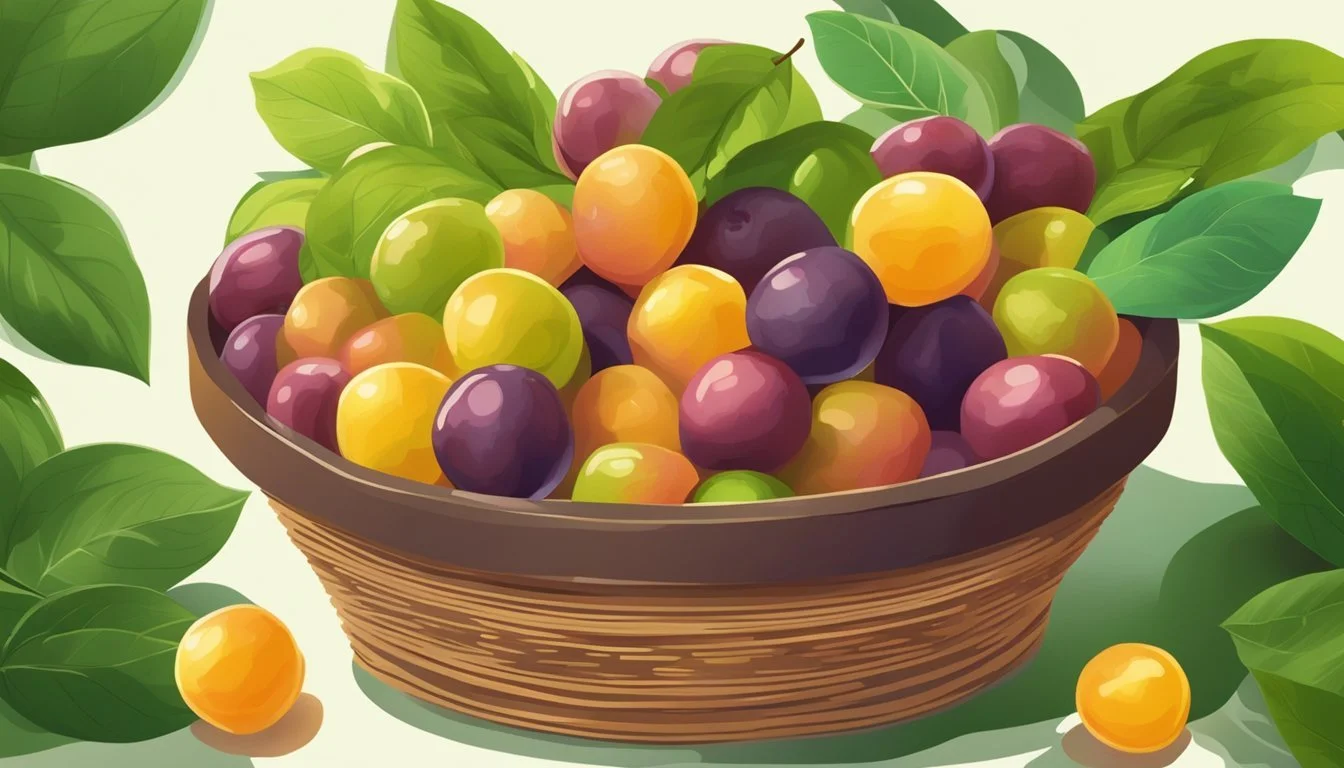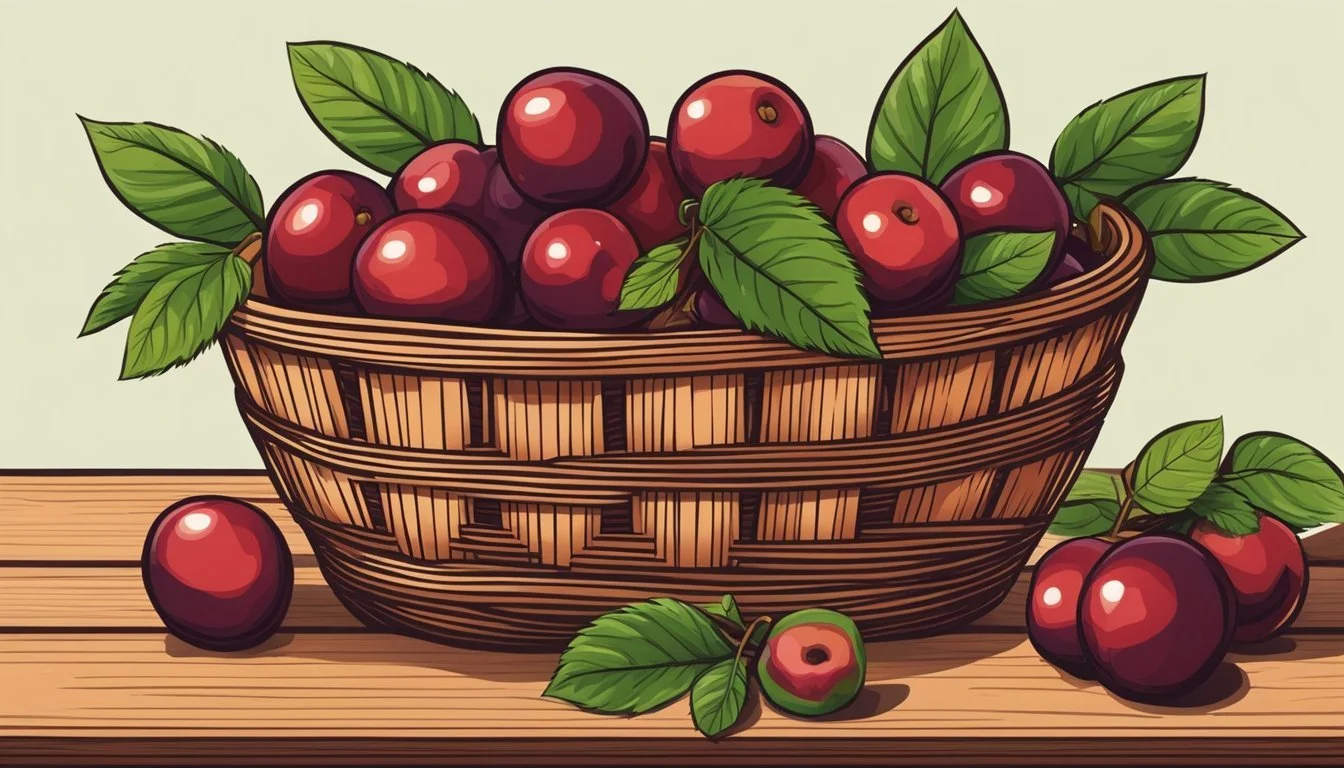How to Tell if Jujubes Are Ripe
Identifying Perfect Harvest Time
Jujubes, with their sweet and slightly tangy flavor, are becoming an increasingly popular fruit for both their taste and health benefits. Telling when a jujube is ripe is crucial for enjoying its best flavor and texture. Ripeness in jujubes is marked by a deep red color and a slight give when gently pressed. If picked too early, jujubes may be hard and sour; too late, and they may become overly soft and lose their distinctive taste.
Harvesting jujubes at the right time requires a careful approach to ensure the fruit’s quality. It is preferable to cut the fruit with a small portion of the stem attached to prevent damage. Once harvested, jujubes should be handled with care and stored properly to extend their shelf life and maintain their nutritional value. For a delicious and healthy addition to the diet, ripe jujubes can be eaten fresh, dried, or used in various recipes.
Key Takeaways
Jujubes are ripe when they have a deep red color and are slightly soft to touch.
Proper harvesting and handling preserve the fruit's quality and taste.
Ripe jujubes can be enjoyed fresh, dried, or in culinary preparations.
Identifying Jujube Ripeness
To ensure the optimal taste and texture, recognizing the signs of ripeness for jujubes is essential. These indicators can guide one through the nuances of harvesting this unique fruit, often referred to as the Chinese or red date.
Color and Texture Indicators
When jujubes approach ripeness, their color changes from green to a deep red or mahogany. Initially, the fruit's skin is smooth, firm, and green. As they mature, jujubes may develop brown spots and become partially wrinkled. A fully ripe jujube will exhibit a wholly brown or reddish-brown hue with more pronounced wrinkles, similar in appearance to a date. The texture moves from firm to slightly spongy upon reaching full ripeness.
Size and Shape Considerations
Jujubes retain a small to medium size and an ovate or round shape as they ripen. It is important to note that size is not a definitive indicator of ripeness, as the fruit stops growing in size before the ripening process concludes.
Taste and Aroma Profiles
A ripe jujube has a sweet, apple-like taste when freshly picked and exhibits an aroma that is subtly fragrant. Over time, as jujubes ripen further off the tree, they develop a taste akin to candy or apples. Unripe jujubes have a markedly astringent taste and should be avoided to prevent an unpleasant eating experience.
Harvest Timing
Harvesting jujubes at the correct time is crucial for quality. They should be picked when they have turned nearly 50% brown but still exhibit patches of green. The fruit should feel firm and are best consumed fresh at this stage. Once fully brown, they begin to lose moisture but can still be harvested for drying.
Common Ripening Misconceptions
A common misconception is that size indicates ripeness, but this is not the case with jujubes. Another is that the fruit will not ripen after being picked; in fact, jujubes can continue to ripen off the tree. It is also often thought that wrinkled jujubes have gone bad. Wrinkling is a natural part of the ripening process, signifying that the jujube is ready to be eaten or dried.
Harvesting and Handling Techniques
Understanding the proper techniques for harvesting and handling jujube fruits ensures a high-quality yield. From selecting the correct tools to storing the fruit for optimal freshness, each step plays a pivotal role in maintaining the integrity of the jujubes.
Tools and Equipment
Pruning Shears: Clean, sharp pruning shears are essential for cutting jujubes from the tree. They should allow for a precise cut to avoid harm to both the fruit and the tree.
Gloves: Durable gloves protect the hands during harvesting and handling, reducing potential injury from the tree's branches.
Storage Containers: Use ventilated containers for collecting the jujubes to permit airflow and minimize bruising.
Proper Harvesting Methods
Jujube fruits are typically ready for harvest in late summer to early fall. The fruit should be dark in color, with no green undertones, and the skin should appear slightly wrinkled. To harvest:
Select jujubes that yield slightly to pressure but are not overly soft.
Cut the fruit with pruning shears, leaving a small portion of the stem attached.
Harvest in the morning when temperatures are cooler to reduce stress on the tree.
Post-Harvest Handling
After harvest, proper handling is crucial to preserve the fruit's quality:
Transfer the jujubes gently into the prepared containers to minimize bruising.
Store at a cool and dry place; refrigeration can extend freshness.
Avoid stacking containers as pressure can lead to blemishes and spoilage.
Avoiding Damage and Blemishes
Preventing damage is key to securing the longevity of the jujube fruit post-harvest:
Inspect for any signs of disease or pest damage and discard affected fruits.
Storage conditions should be consistent with minimal temperature fluctuations to prevent spoilage.
Regularly check stored jujubes and remove any fruit that begins to deteriorate to keep the rest fresh.
Benefits of Eating Jujubes
Jujubes, both fresh and dried, boast significant health advantages and are ingrained in various cultural practices. They provide essential nutrients, support wellness, have versatile culinary uses, and hold a place of importance in traditional customs.
Nutritional Value
Jujubes are nutritionally dense fruits known for their content of vitamin C, potassium, and fiber. A 100-gram serving of jujubes typically offers:
Calories: 79
Fat: 0g
Carbs: 20g
Fiber: Approximately 50% of total carbohydrates
Protein: 1.2g
Potassium: 250mg
Vitamin C: 69mg
Calcium: 21mg
Health and Wellness
The health benefits of jujubes are extensive. The vitamin C in jujubes contributes to immune system support, while fiber aids in maintaining digestive health. Besides these, jujubes contain other beneficial compounds that have been utilized in Traditional Chinese Medicine to promote sleep and reduce anxiety.
Culinary Uses
Culinarily, jujubes are a versatile fruit. They can be eaten fresh, used in tea, made into jam, or included in various dishes from Asian cuisines like cakes, cookies, sauces, and compotes. Particularly in Asian countries, such as China and Korea, as well as American markets, Lang jujubes are sought after for their sweet taste.
Cultural Significance
Jujubes have a long-standing cultural significance across Asia, particularly in China. They are not just a fruit but a symbol of prosperity and peace. Traditionally used in festive foods and traditional medicines, jujubes are embedded in the cultural fabric from everyday diet to celebratory occasions.
Storing Jujubes for Longevity
Storing jujubes properly extends their shelf life and preserves their unique flavor. This section outlines the optimal storage conditions for fresh jujubes, effective drying techniques, and the best solutions for storing dried jujubes to ensure freshness over time.
Optimal Conditions for Fresh Jujubes
Fresh jujubes maintain their quality when stored at temperatures between 52°F and 55°F. To prevent spoilage and maintain moisture:
Refrigerator: Place jujubes in a perforated plastic bag or an airtight container and refrigerate them. They can last 1-2 weeks in this condition.
Inspection: Regularly check for any signs of spoilage and remove affected fruits to protect others.
Techniques for Drying Jujubes
Drying jujubes transforms them into a long-lasting treat. To dry jujubes:
Preparation: Wash and pat them dry; remove pits if desired.
Drying Equipment: Use a dehydrator or air-dry them on a rack in a warm, ventilated area.
Dehydrator Temperature: Set between 125°F to 135°F for optimal drying.
Timing: Drying can take up to 24 hours, depending on size and moisture content.
Storage Solutions for Dried Jujubes
Once jujubes are dried, they should be stored to maintain their shelf life.
Containers: Use airtight containers to protect from moisture and pests.
Environment: Store in a cool, dry place away from direct sunlight to prevent degradation.
Extending Shelf Life Through Proper Care
Proper care can significantly extend the longevity of both fresh and dried jujubes.
Airflow: Ensure adequate ventilation in storage areas to prevent mold.
Hygiene: Clean storage containers regularly to reduce risk of contamination.
Monitoring: Keep an eye on the storage conditions and adjust as necessary to maintain quality.
By following these guidelines, one can ensure that their jujubes remain delicious and edible for as long as possible, whether they are enjoying them fresh or as a dried snack.
Cultivation and Care of Jujube Trees
Cultivation of jujube trees focuses on meeting growing requirements, regular maintenance, and vigilant pest and disease management to ensure a healthy and productive tree.
Growing Requirements
Jujube trees, known for their resilience, thrive in a wide range of conditions. They require full sunlight and well-drained soil for optimal growth. These trees can tolerate drought and prosper in a variety of soil types, although they perform best in alkaline soils with a pH between 6 and 7.5.
Temperature: Jujube trees can withstand temperatures well below freezing, although they prefer warm climates for fruit setting.
Watering: While drought-tolerant, consistent watering during the growing season enhances fruit production.
Spacing: Trees should be spaced 10 to 15 feet apart to allow for growth and air circulation.
Maintenance and Pruning Practices
Jujube trees require minimal pruning. They are typically pruned to remove dead or crossing branches to maintain tree structure and health. Pruning should be done with clean, sharp pruning shears. Maintenance also includes:
Thinning the fruits to prevent branch breakage and to ensure larger, quality jujubes.
Removing suckers that sprout from the rootstock to maintain tree vigor.
Clearing fallen leaves and debris to minimize disease risk.
Pest and Disease Management
Jujube trees are not heavily afflicted by pests and diseases; however, growers should remain observant. Common pests include:
Jujube fruit flies: They can be controlled with traps or insecticides.
Aphids: Regular monitoring and natural predators usually keep them in check.
Diseases are rare but may include:
Fruit rot: Caused by fungi and can be mitigated by proper air circulation and tree care.
Witch’s broom: A phytoplasma disease, which requires removal of affected parts.
Regular inspections and early interventions are essential for maintaining the health of jujube trees.
Recipes and Preparations
Jujubes are a flexible ingredient that can be used in both sweet and savory dishes, with varied preparation methods dependent on whether they are fresh or dried. The culinary uses of jujubes span from beverages and jams to desserts and savory sauces.
Jujube Tea and Beverages
Jujube Tea: For a soothing drink, simmer 10 dried jujubes with 1 piece of ginger and 5 cups of water for about an hour. Optionally, add goji berries for additional flavor and health benefits.
Cocktails and Non-alcoholic Beverages: Fresh jujubes can be muddled and added to cocktails or lemonades, providing a unique sweet taste.
Jams and Compotes
Jujube Jam: Combine 2 pounds of fresh jujubes, pitted and chopped, with 1 cup of sugar and 2 tablespoons of lemon juice. Cook over medium heat until the fruit breaks down and the mixture thickens.
Compote: For a simple compote, soak 1 pound of dried jujubes in water, then simmer with cinnamon and star anise until tender.
Cakes, Cookies, and Desserts
Cakes and Breads: Pureed jujubes can be mixed into cake or bread batters, as their sweetness pairs well with spices such as cinnamon or nutmeg.
Cookies: Chopped dried jujubes add a chewy texture to cookies, similar to raisins or dates. Fold in 1/2 cup of dried, chopped jujubes into your favorite cookie dough.
Savory Dishes and Sauces
Stews and Soups: Incorporate jujubes into stews or soups by adding a handful of the dried fruit, which will plump up and infuse the dish with a mild, sweet flavor.
Sauces: Pureed jujubes can be used as a base for sweet and tangy sauces, ideal for accompanying meats or tofu.
Conclusion
Determining the ripeness of jujubes is key to enjoying their best taste and texture. Ripe jujubes should exhibit a smooth transition from green to a deep red or brown, and have a slightly wrinkled appearance when they're at peak ripeness. Overripe fruits tend to become mushy, while underripe ones remain hard and lack sweetness.
For those interested in drying jujubes, harvesting should occur when the fruit is fully ripe. Using a dehydrator or air-drying them can preserve the fruit effectively. Keep in mind to store jujubes in a cool, dry place to maintain their quality.
Remember the following points:
Space: Plant trees 10 to 15 feet apart.
Watering: Crucial for young trees and quality fruit development.
Harvesting: Discard any damaged or diseased fruits; harvest with a bit of stem for drying.
In conclusion, attention to detail in the ripening stage and proper care during planting and growing will lead to a successful jujube harvest. By adhering to these guidelines, one ensures a supply of flavorful and textured jujubes whether they are consumed fresh, dried, or used in various culinary applications.




